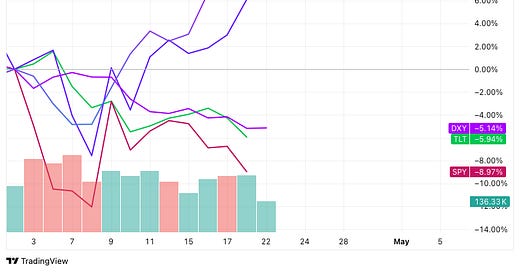Has the Market's Response to Risk Changed?
Tariffs are the headline, but what's under the surface?
Recent sweeping tariffs, announced on what some have painfully dubbed "Liberation Day" triggered a significant market reaction. But I don't just mean the usual uptick in stock market volatility often seen with major policy shifts. The way various asset classes responded diverged from the standard crisis playbook in ways that warrant further consideration.
The Standard Crisis Playbook
In times of acute market stress or economic uncertainty, asset price movements usually follow a fairly predictable pattern – the classic "flight to safety":
Risk Assets Sell Off: Stocks, particularly growth-oriented sectors, and cryptocurrencies tend to decline. The higher the perceived risk, generally the larger the sell-off as investors reduce exposure.
Government Bonds Rally: Investors seek perceived safety in government debt, especially US Treasuries. This increased demand pushes bond prices up and, consequently, yields down.
US Dollar Strengthens: The USD often acts as a global haven. Demand for dollars increases as international investors seek safety and liquidity, strengthening it against other major currencies (often tracked by the DXY index).
Gold's Mixed Reaction: Gold sometimes sees an initial sell-off amid broad liquidation but often strengthens afterwards as investors seek a store of value outside of fiat currencies and bonds, especially if inflation fears creep in.
We saw clear examples of this playbook during the COVID-19 panic in March 2020 and the Global Financial Crisis (GFC) beginning around 2008. The narrative is straightforward: facing uncertainty, capital flees risky assets and rushes into perceived safe havens like US Treasuries and the US dollar. It's a market tale seemingly as old as time.
Here is the example from COVID-19. Keep in mind that the crash was short lived due to government and central bank intervention.
Now Trump is back at the helm and tariffing every living beast under the sun including the poor penguins of the Heard and McDonald Islands. I won’t spill any ink on the tariffs as I’m sure you’ll get your fill elsewhere. However, how the markets have responded is well worth a closer look.
For the first day or two after the announcement, markets seemed to follow the old script. However, a distinct pattern emerged shortly after:
Stocks Sold Off: This aligned with expectations. Risk assets faced pressure (illustrated by the SPY, an S&P 500 ETF, in the chart below).
US Dollar Sold Off: This is unusual. Instead of strengthening, the Dollar Index (DXY) weakened. The typical flight to USD safety didn't materialize.
Government Bonds Sold Off: Highly unusual. Instead of rallying (prices up, yields down), US Treasuries sold off (represented by TLT, a long-term Treasury ETF, in the chart below). This means prices fell, and yields rose, even as stocks were declining. This is the opposite of the standard risk-off playbook.
Gold Rallied Strongly: Gold didn't just recover after an initial dip; it rallied quite rapidly, suggesting immediate demand as a safe haven.
Bitcoin Held Firm, Then Rallied: Initially stable, Bitcoin later joined gold in moving higher.
A Potential Regime Shift?
This divergence is significant and shouldn't be glossed over. If major risk events no longer reliably trigger flows into US Treasuries and the US dollar, it signals a potential fundamental shift in how global capital perceives safety.
The obvious explanation to the above reaction is that gold, bitcoin and other currencies are the primary benefactor in this flight to safety. The fact bitcoin is even in this conversation is astounding. Although I view bitcoin positively and am bullish long-term (more on this in another post I’m sure), it has traded as a risk asset up until now. This is a fundamental shift in how it is being perceived. It’s only been a couple of weeks so I won’t be getting too giddy just yet.
Projecting anything in the short-to-medium term is fraught as it is heavily dependent on what comes out of the White House. Volatility is about the only thing I will predict at this point (you’re welcome).
This post briefly outlined the what – the unusual market response to the Liberation Day tariff bonanza. The crucial task for investors is anticipating what comes next. I have thoughts on potential scenarios but I’ll leave the speculation to the next post.




